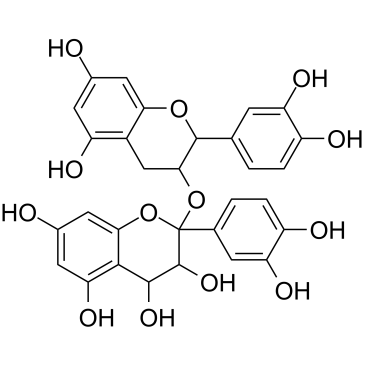Proanthocyanidins |
| カタログ番号GC38218 |
抗酸化作用を持つポリフェノール
Products are for research use only. Not for human use. We do not sell to patients.

Cas No.: 20347-71-1
Sample solution is provided at 25 µL, 10mM.
Proanthocyanidins are a class of polyphenolic that are widely distributed in higher plants, consisted of an electrophilic flavanyl unit. Proanthocyanidins can be used as antioxidant and anti-cancers agent. Proanthocyanidins also exhibit anti-inflammatory, cardioprotective, antibacterial and antifungal properties, which can be used in the treatment of chronic venous insufficiency, capillary fragility, sunburn and retinopathy.[1].
Proanthocyanidins are present in plants as complex mixtures of polymers. Predominant food sources are red wine, tea, chocolate and fruits like grapes, apples, pears, and cranberries[1].The most interesting antibacterial activity of Proanthocyanidins is related to their presence in cranberries (Vaccinium macrocarpon Ait.). A number of clinical trials have demonstrated the effectiveness of cranberry consumption in preventing urinary tract infections (UTIs). Although UTIs can be caused by many microorganisms, more than 85% are caused by Escherichia coli. The presence of P-fimbriae on E. coli, which are proteinaceous fibers on the bacterial cell wall, has been clearly established as a virulence factor, since they are responsible by producing adhesions for adherence to uroepithelial cells. Recently, it is demonstrated that cranberry Proanthocyanidins might inhibit P-fimbriated E. coli from adhering to uroepithelial cells. The antiadhesion activity of cranberry juice appears to be related to the presence of Proanthocyanidins with at least one A-type linkage[1].
The effects of cacao liquor Proanthocyanidins on 2- amino-1-methyl-6-phenylimidazo [4,5-b] pyridine-induced mutagenesis in vivo carcinogenesis in female Sprague-Dawley rats are investigated. In the Ames assay, Proanthocyanidins shows strong antimutagenic effects when assayed in the presence of S-9 mixture. They also inhibit significantly rat pancreatic carcinogenesis in the initiation stage, but not mammary carcinogenesis[1].
[1]. Kruger, Maria J, et al. Proanthocyanidins, anthocyanins and cardiovascular diseases. Food research international 2014 v.59 pp. 41-52 [2]. Cos P, et al. Proanthocyanidins in health care: current and new trends. Curr Med Chem. 2004 May;11(10):1345-59.
Average Rating: 5 (Based on Reviews and 35 reference(s) in Google Scholar.)
GLPBIO products are for RESEARCH USE ONLY. Please make sure your review or question is research based.
Required fields are marked with *




















